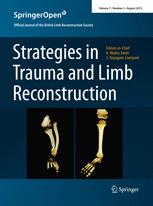
ORIF with volar locking plates provide better functional outcome than external fixation

ORIF with volar locking plates provide better functional outcome than external fixation
Functional outcome in patients with unstable distal radius fractures, volar locking plate versus external fixation: a meta-analysis
Strategies Trauma Limb Reconstr. 2013 Aug;8(2):67-75. doi: 10.1007/s11751-013-0169-4. Epub 2013 Jul 28Synopsis
Three randomized clinical trials were included in this meta-analysis which compared open reduction and internal fixation (ORIF) with volar locking plates to bridging external fixation in the treatment of unstable distal radius fractures. Disabilities of the Arm, Shoulder and Hand (DASH) scores at 3, 6, and 12 months were significantly better in patients who received ORIF. There was no significant difference between treatments for complication rates.
Were the search methods used to find evidence (original research) on the primary question or questions stated?
Was the search for evidence reasonably comprehensive?
Were the criteria used for deciding which studies to include in the overview reported?
Was the bias in the selection of studies avoided?
Were the criteria used for assessing the validity of the included studies reported?
Was the validity of all of the studies referred to in the text assessed with use of appropriate criteria (either in selecting the studies for inclusion or in analyzing the studies that were cited)?
Were the methods used to combine the findings of the relevant studies (to reach a conclusion) reported?
Were the findings of the relevant studies combined appropriately relative to the primary question that the overview addresses?
Were the conclusions made by the author or authors supported by the data and or analysis reported in the overview?
How would you rate the scientific quality of this evidence?
Yes = 1
Uncertain = 0.5
Not Relevant = 0
No = 0
The Reporting Criteria Assessment evaluates the transparency with which authors report the methodological and trial characteristics of the trial within the publication. The assessment is divided into five categories which are presented below.
4/4
Introduction
4/4
Accessing Data
4/4
Analysing Data
2/4
Results
3/4
Discussion
Detsky AS, Naylor CD, O'Rourke K, McGeer AJ, L'Abbé KA. J Clin Epidemiol. 1992;45:255-65
The Fragility Index is a tool that aids in the interpretation of significant findings, providing a measure of strength for a result. The Fragility Index represents the number of consecutive events that need to be added to a dichotomous outcome to make the finding no longer significant. A small number represents a weaker finding and a large number represents a stronger finding.
Why was this study needed now?
Distal radius fractures are fairly common, and controversy exists as to the most effective surgical treatment. Bridging external fixation, either with or without Kirschner wires, has traditionally been seen as a fast and effective procedure. However, proponents of open reduction and internal fixation (ORIF) with locking plates underline that the immediate stable fixation with ORIF may allow for better recovery. To date, there has been no conclusive evidence to advocate one surgical treatment over the other.
What was the principal research question?
Was there a superior surgical option between ORIF with locking plates and bridging external fixation when concerning fractures of the distal radius?
What were the important findings?
- A total of 3 studies were included in this meta-analysis
- Differences in DASH score significantly favoured ORIF with volar locking plates over bridging external fixation at 3 months (MD -15.58 (95%CI -24.52 to -6.64); P=0.006), 6 months (MD -6.20 (95%CI -9.83 to -2.58); P=0.008), and 12 months (MD -8.00 (95%CI -15.55 to -0.44); P=0.04) following surgery.
- The heterogeneity in the analyses of DASH scores at 3 months (I^2 = 72%) and 12 months (I^2 = 63%) was substantial.
- There was no significant difference between treatments when considering pooled complication rate (OR 0.71 (95%CI 0.34-1.46); P=0.35).
What should I remember most?
Open reduction and internal fixation with volar locking plates resulted in a significantly better functional outcome on the Disabilities of the Arm, Shoulder, and Hand (DASH) measurement at 3, 6, and 12 months postoperatively compared to bridging external fixation. Clinical significance of the mean difference in DASH scores at 6 and 12 months is yet unclear as it falls below the threshold of 10 points for definite clinical significance.
How will this affect the care of my patients?
Early functional recovery appears to be benefited by ORIF for unstable distal radial fractures. This intervention may, therefore, be more appealing to patients with a higher postoperative functional demand. Future analyses should consider a wider array of outcome variables to add to the body of evidence concerning ORIF and external fixation for distal radius fractures.
Learn about our AI Driven
High Impact Search Feature
Our AI driven High Impact metric calculates the impact an article will have by considering both the publishing journal and the content of the article itself. Built using the latest advances in natural language processing, OE High Impact predicts an article’s future number of citations better than impact factor alone.
Continue



 LOGIN
LOGIN

Join the Conversation
Please Login or Join to leave comments.